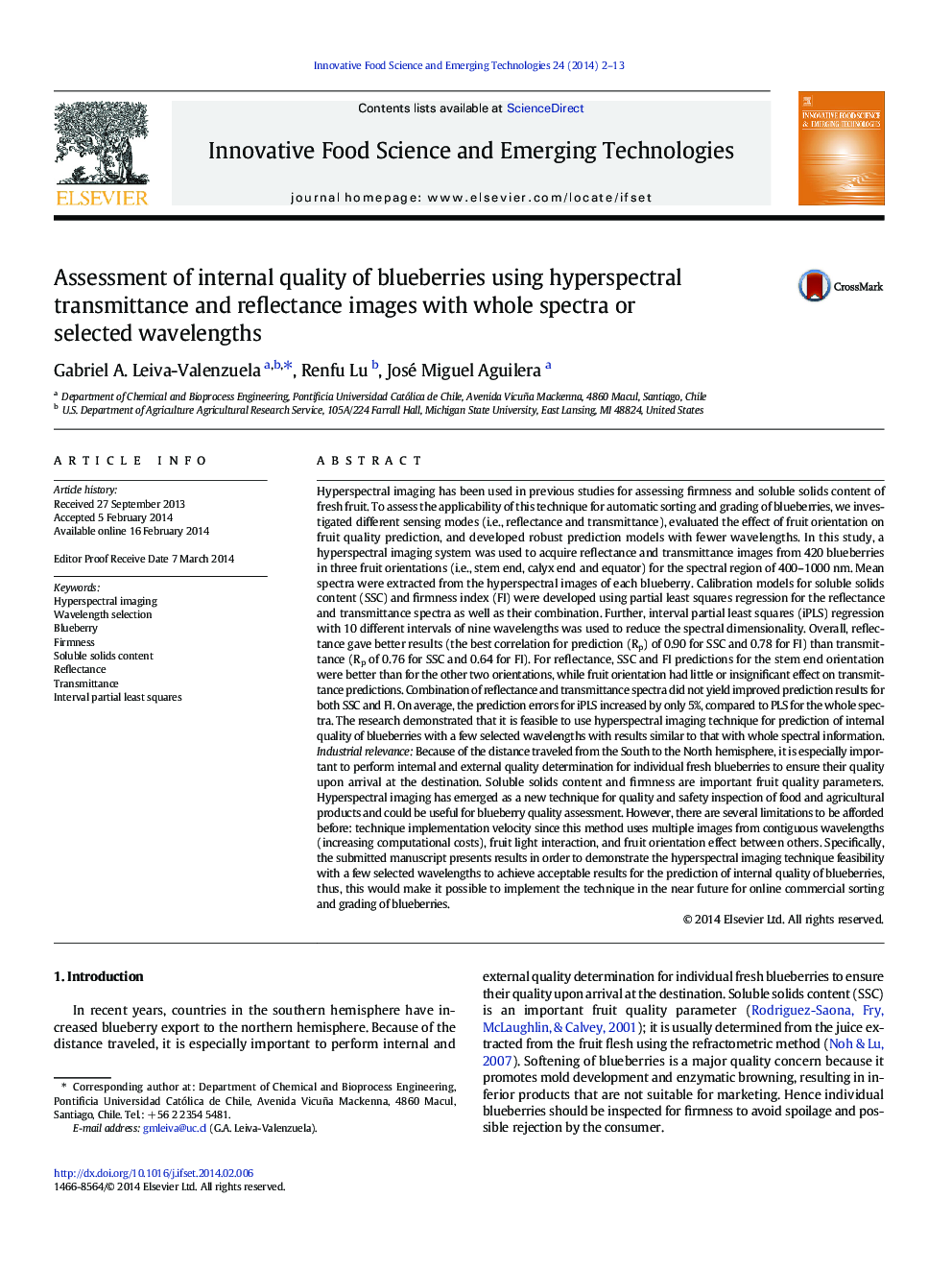| کد مقاله | کد نشریه | سال انتشار | مقاله انگلیسی | نسخه تمام متن |
|---|---|---|---|---|
| 2086714 | 1545542 | 2014 | 12 صفحه PDF | دانلود رایگان |
• Blueberry's internal quality was assessed using hyperspectral images.
• Reflectance sensing mode performed significantly better than transmittance mode in predicting SSC and FI.
• Fruit orientation had no or little effect on the prediction of firmness and SSC.
• Selecting wavelengths increased the standard error by no more than 5% for quality parameters
• This technique may be appropriate for inline sorting of blueberry.
Hyperspectral imaging has been used in previous studies for assessing firmness and soluble solids content of fresh fruit. To assess the applicability of this technique for automatic sorting and grading of blueberries, we investigated different sensing modes (i.e., reflectance and transmittance), evaluated the effect of fruit orientation on fruit quality prediction, and developed robust prediction models with fewer wavelengths. In this study, a hyperspectral imaging system was used to acquire reflectance and transmittance images from 420 blueberries in three fruit orientations (i.e., stem end, calyx end and equator) for the spectral region of 400–1000 nm. Mean spectra were extracted from the hyperspectral images of each blueberry. Calibration models for soluble solids content (SSC) and firmness index (FI) were developed using partial least squares regression for the reflectance and transmittance spectra as well as their combination. Further, interval partial least squares (iPLS) regression with 10 different intervals of nine wavelengths was used to reduce the spectral dimensionality. Overall, reflectance gave better results (the best correlation for prediction (Rp) of 0.90 for SSC and 0.78 for FI) than transmittance (Rp of 0.76 for SSC and 0.64 for FI). For reflectance, SSC and FI predictions for the stem end orientation were better than for the other two orientations, while fruit orientation had little or insignificant effect on transmittance predictions. Combination of reflectance and transmittance spectra did not yield improved prediction results for both SSC and FI. On average, the prediction errors for iPLS increased by only 5%, compared to PLS for the whole spectra. The research demonstrated that it is feasible to use hyperspectral imaging technique for prediction of internal quality of blueberries with a few selected wavelengths with results similar to that with whole spectral information.Industrial relevanceBecause of the distance traveled from the South to the North hemisphere, it is especially important to perform internal and external quality determination for individual fresh blueberries to ensure their quality upon arrival at the destination. Soluble solids content and firmness are important fruit quality parameters. Hyperspectral imaging has emerged as a new technique for quality and safety inspection of food and agricultural products and could be useful for blueberry quality assessment. However, there are several limitations to be afforded before: technique implementation velocity since this method uses multiple images from contiguous wavelengths (increasing computational costs), fruit light interaction, and fruit orientation effect between others. Specifically, the submitted manuscript presents results in order to demonstrate the hyperspectral imaging technique feasibility with a few selected wavelengths to achieve acceptable results for the prediction of internal quality of blueberries, thus, this would make it possible to implement the technique in the near future for online commercial sorting and grading of blueberries.
Journal: Innovative Food Science & Emerging Technologies - Volume 24, August 2014, Pages 2–13
